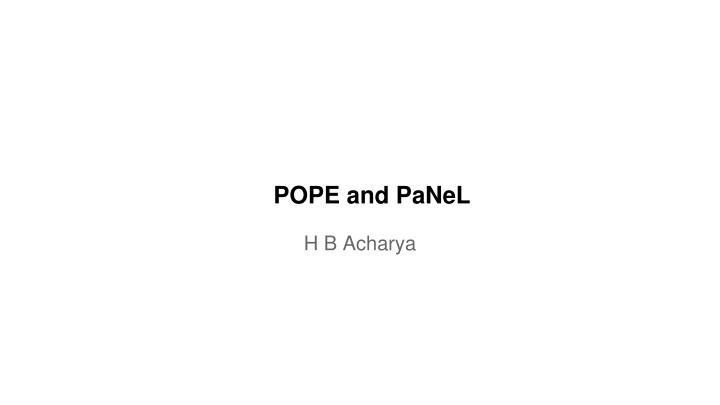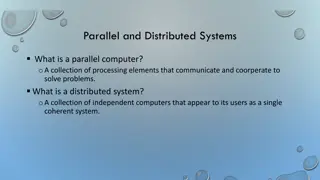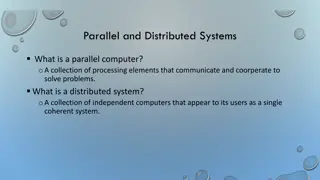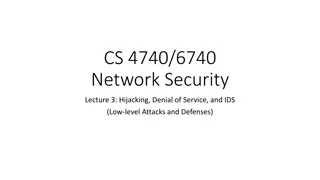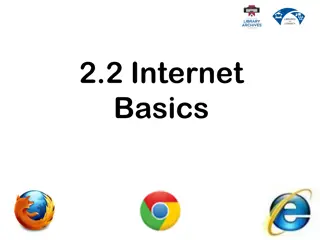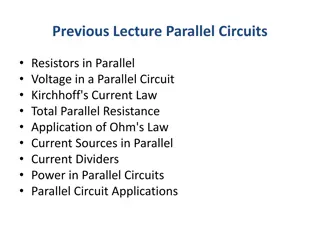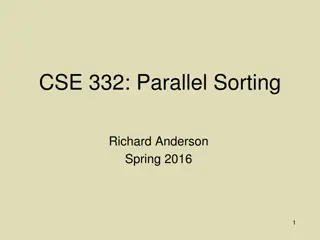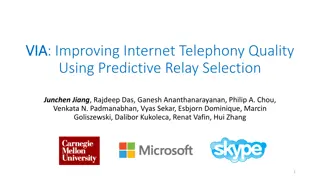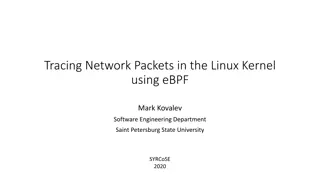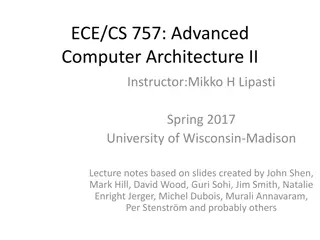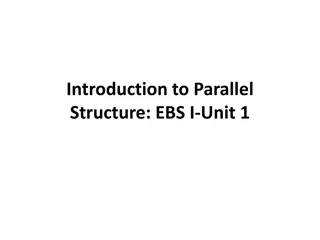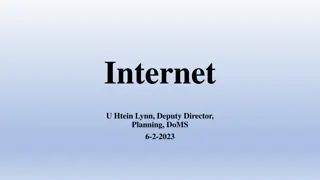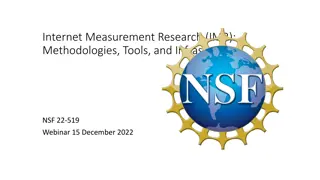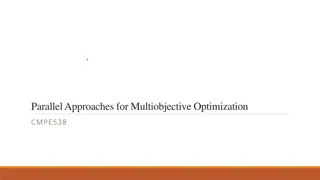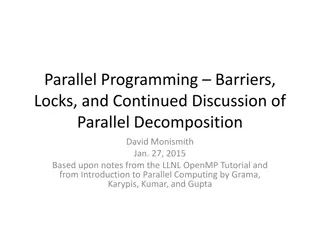Enhancing Internet Backbone Performance through Parallel Resolution of Packets and Rules
The bottleneck in Internet backbones lies in the decision-making process for incoming packets. This article explores the challenges faced in efficiently processing policies in routers and middleboxes by introducing parallel resolution techniques to increase throughput and reduce latency. It discusses the distinction between concurrency and parallelism, the necessity of evaluating policies in parallel, and the complexities of rule precedence in large and overlapping rule sets.
Download Presentation

Please find below an Image/Link to download the presentation.
The content on the website is provided AS IS for your information and personal use only. It may not be sold, licensed, or shared on other websites without obtaining consent from the author.If you encounter any issues during the download, it is possible that the publisher has removed the file from their server.
You are allowed to download the files provided on this website for personal or commercial use, subject to the condition that they are used lawfully. All files are the property of their respective owners.
The content on the website is provided AS IS for your information and personal use only. It may not be sold, licensed, or shared on other websites without obtaining consent from the author.
E N D
Presentation Transcript
POPE and PaNeL H B Acharya
Motivation: The Bottleneck S. Keshav : the rate limiting step in Internet backbones is deciding which action to perform on an arriving packet o Policies in routers and middleboxes consist of rules; the challenge is to quickly decide which rule applies To increase throughput, we match different packets in parallel o But this still requires the latency of checking all the rules
Parallel = Fast? Concurrency simply means there is not a serializing causal dependency things can happen in any order Parallelism means things actually happen at the same time Policies are sequential: there is an order of precedence for the rules in a policy. Can they be evaluated in parallel (without an O(n) wait?)
Contents Packets and Rules Matching and Resolution XMT Parallel Resolution o starring Prefix-Sum POPE and PaNeL
Packets and Rules Decisions on packets are made based on the header values o Source and Destination address and port, protocol, etc. o These values are represented by integers We represent a packet by a tuple of d integers o Each representing a field of interest, e.g. source IP o An example packet might be <7, 918, 4, 5, 14> A rule consists of two components o A guard: d integer intervals (one for each field) o A decision specifying an action to take, eg. accept, discard
The Matching of Packets A rule matches a packet if o for all d fields, o the value specified by the packet lies in the corresponding interval specified in the rule. For example, the rule <[10, 100], [0, 255]> -> discard matches the packet <51, 0> and not <101, 0>
Policies and Rule Precedence Practical policies can be large and complex o A routing table of 10^5 rules is not unusual These rules can overlap o When multiple rules match the same packet, which applies? o Rule precedence!
The order of rules In practice, the order of rules is quite complex The rule with the best match (the smallest specified interval) among the matching rules wins To break ties, rules are ordered as follows o Static routes o Dynamic routes, in order the usual order is EIGRP, OSPF, ISIS, RIP o Default routes
Introducing XMT Serial computation: von Neumann machine o all memory accesses (from the one processor) occur at once o an instruction, available for execution, executes immediately Parallel computation: PRAM o all memory accesses, from any processor, occur at once XMT is a PRAM-like machine o many instructions, available for execution, execute immediately, in parallel
Why XMT? O(1) Random Memory Access from any processor Many Core Architecture (1024 cores) leads to better speedup. Simple and efficient architecture: each Thread Control Unit (core) runs a thread independent of the others The XMT-C programming language is simple
Matching Rules in Parallel Spawn a thread for each rule in the policy (in parallel) The thread corresponding to a rule checks whether that rule matches the packet or not In O(1) time [or more accurately O(d) if we check d fields] we find, for each rule, whether it matches the incoming packet
The Precedence Problem! For a rule to match a packet is NOT enough! When multiple rules match a packet (and have different actions) the conflict is resolved using match semantics o We use first-match semantics: the first rule to match a packet is the one applied. o This rule is said to resolve the packet Serial checking: stop after the first rule matches the packet Parallel checking: how to tell first match?
Restating the First Match problem Consider an array A[n] Each value of the array corresponds to a rule in the policy o A[i] = 1 iff rule i matches the packet o A[i] = 0 otherwise Finding the first rule to match the packet reduces to finding the smallest i s.t. A[i] = 1
First Match with Prefix Sums There exists a standard algorithm to compute prefix match of an array of n elements in O(log n) o Prefix sum A+of array A is an array of length n, such that A+[i] = A[1]+A[2] + A[i] For the first i such that A[i] = 1, A+[i] = 1 also This is true only for this element. o Therefore, we can resolve packets in O(1) + O(log n) + O(1) time rather than O(n) time, thanks to the O(log n) prefix-sum algorithm.
First Attempt : POPE For every rule in parallel, try to match the packet and store the result of the attempt in corresponding space in A. Each value of the array corresponds to a rule in the policy o A[i] = 1 iff rule i matches the packet o A[i] = 0 otherwise Compute A+, the prefix sum of A Perform the action of the rule no. i where A[i] == A+[i] == 1
Scaling Problems POPE works very well for small policies However, the performance drops off for larger policies (say of the order of 104rules and above) The reason is simple: POPE always checks ALL the rules o Whereas serial resolution stops after the first match which in a large policy, is likely to happen early, i.e. in rules high up in the policy
Second Attempt: PaNeL Divide large policies up into batches of rules o We find experimentally that batches of 1000 rules work best o Probably because XMT had 1024 cores? Perform the POPE algorithm batch by batch, until the first match is found. (One batch at a time) This reduces the average running time, though not the worst case
To Do Compare the performance of parallelizing rule matching of packets versus the solution of matching multiple packets in parallel. o Perhaps combine both approaches The performance seems to vary with the width index the bit width of the fields tested. Further study is indicated
Prefix Sum 1 2 3 4 3 7 10 1 2 3 4 3 10 10
Prefix Sum 1 3 3 10 3 10 10 1 3 6 10 3 10 10
